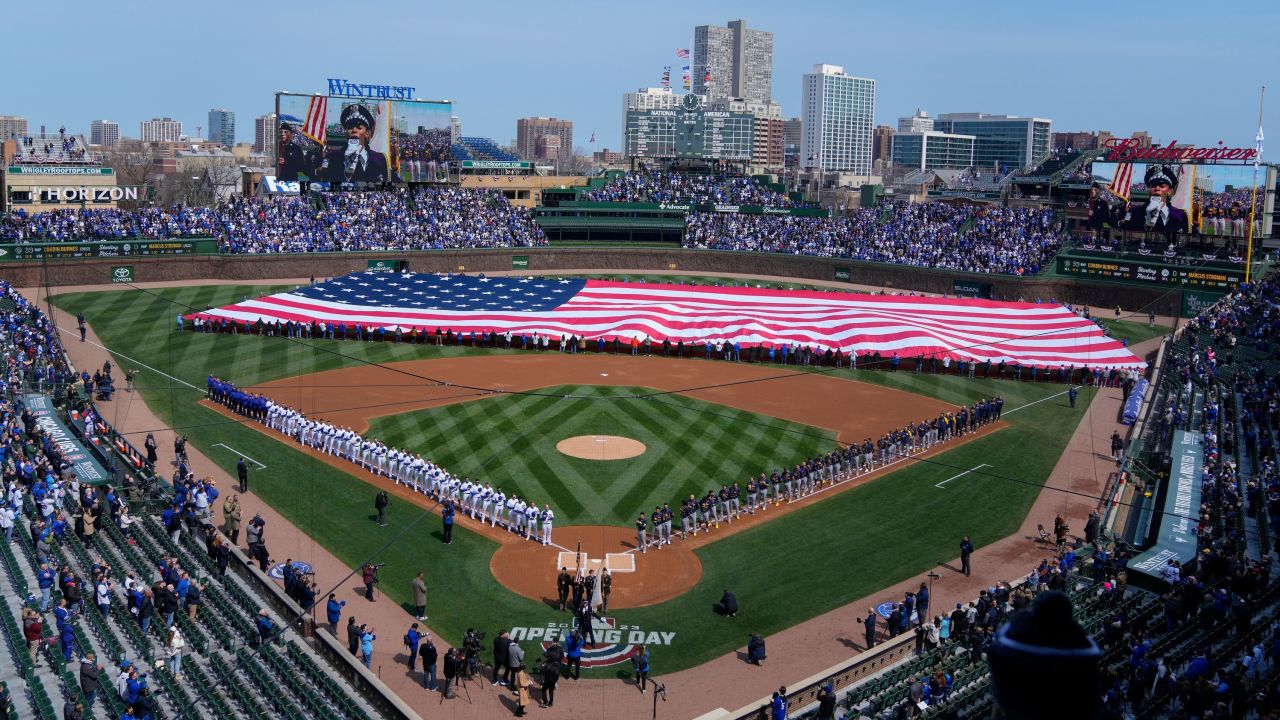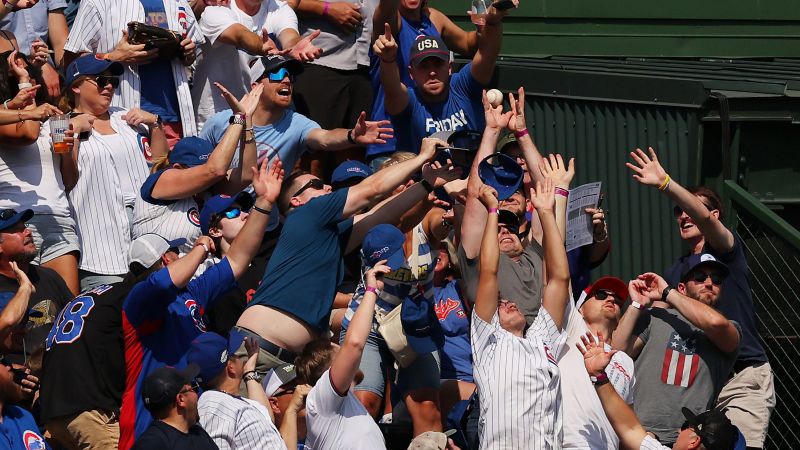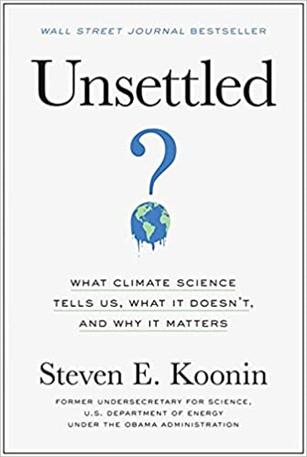it's a great revelation of proof finally. what i don't see him mentioning though is humidity. the ball flies farther in humid conditions for the same reasons. if you go back to your high school chemistry and look at the periodic table, air contains mostly nitrogen and oxygen but water contains a lighter hydrogen so humid air is lighter so the ball flies farther. It turns out that each molecule of water vapor is lighter (18 grams/mole) than each molecule of either nitrogen (28 grams/mole) or oxygen (32 grams/mole). So the more water vapor (humidity) there is in the air around you, the lighter the air is.
CNN —
Whether it’s a change in the baseballs themselves, better analytics or more robust player training, many have speculated about what could be behind the upward trend in Major League Baseball home runs in recent years.
But new research released Friday raised another potential factor: climate change.
The study, published in the Bulletin of the American Meteorological Society, found that more than 500 home runs since 2010 can be linked to unusually warm temperatures. If temperatures continue to warm rapidly because of planet-cooking pollution, climate change could end up accounting for 10% of all home runs by the end of the century.
That’s hundreds of more home runs per season compared to this century’s first two decades.
Christopher Callahan, lead author of the study and a doctoral student in climate modeling and impacts at Dartmouth College, spent his early years in downtown Chicago within walking distance of Wrigley Field, home of the Chicago Cubs.
And as a “baseball nerd,” he wanted to see how climate change could be altering his favorite sport.
“I remember being surprised at how strong the finding was,” Callahan told CNN. “We’re not saying that every home run now is because of climate change, but you take the data and slice it any way you want, you find the same thing.”

A dog steals the show after catching home run ball during spring training game
“And as a fan, I indeed am a little bit frustrated that home runs may continue to dominate, as it does now,” he added.
The physics at play here are relatively simple. Warmer temperatures make air less dense. Molecules in the air are energized when they warm up – they bounce around more and spread out, meaning there’s more empty space between them.
This is why a batted ball will carry farther in warmer, less-dense air, making it all the more likely that a solid hit will result in a home run.
“Passenger jets fly at 30,000 feet, because air density is really low up there, and it just means that planes are more efficient, given the same fuel,” Justin Mankin, an assistant professor of geography at Dartmouth and co-author of the study, told CNN. “We don’t fly passenger jets low in the atmosphere because there’s just so much more stuff in the way.”
Callahan said he was always hearing speculation on the connection between warmer temperatures and home runs from physicists and sports writers, but no one had actually sat down and combed through all the data to prove it.
So he analyzed more than 100,000 MLB games and 220,000 individual hits and overlaid it with unseasonably warm temperatures and found a clear connection: games that were held in open stadiums during the day, when the sun is out, saw a spike in home runs, while games held at night or in domed stadiums would see a smaller number of home runs.
At the Chicago Cubs’ open-air Wrigley Field, for instance, where only a limited number of games are held at night, researchers would expect to see the largest increase in future home runs, with more than 15 additional home runs per season if global average temperature climbs to 4 degrees Celsius above pre-industrial levels. (Global temperature is already around 1.2 degrees warmer than it was in the late 1800s.)
The domed Tropicana Field stadium of the Tampa Bay Rays, however, would not see a meaningful increase, no matter how warm it gets, according to the study.
Ethan Coffel, assistant professor of geography at Syracuse University, who is not involved with the study, said the research succeeded in ruling out other potential factors and homing in on the influence of temperature.
“The authors show that the effect of warming on home runs is less for indoor stadiums and night games, making a somewhat controlled experiment,” Coffel told CNN. “There may have been other changes to gameplay or equipment which could have also affected trends in home runs, but one might not expect those things to differ between indoor and outdoor stadiums or night versus day games.”

Researchers suggest Wrigley Field will see the largest increase in home runs in the coming decades as temperatures warm.
Erin Hooley/AP
Alan Nathan, a professor emeritus of physics at the University of Illinois who led a study to examine a spike in home runs between 2015 and 2017, praised Friday’s research for taking several factors into account, and noted that his less-comprehensive analysis suggested about the same result: that a 1-degree Celsius increase in air temperature would lead to a roughly 2% increase in home runs.
“While the study is very interesting and almost surely correct, a two-ish percent increase in home runs due to a 1-degree Celsius rise in temperature is tiny compared to the actual year-to-year changes, especially during the 2015-2022 period,” Nathan noted.
Still, Mankin and Callahan said the league could use this study as evidence to advocate for climate solutions.
“Global warming is already affecting gameplay for professional baseball. And that’s just going to continue in the future and that effect will get stronger,” Mankin said. “A billion-dollar organization can also start to put its mic towards advocating for mitigation measures. And I think that’s really important – a powerful sports organization coming out and saying, ‘Hey, this is affecting one of the most important cultural touchstones in America.’”
MLB declined to comment on the study, but pointed to their environmental sustainability efforts, including its “Green Glove Award,” which goes to the team with the highest recycling rate.
Callahan said there are two things MLB could change in the near-term to limit the effect: switching to more domed stadiums to insulate the game from rising temperatures, or shifting schedules to more night games – though the latter could be difficult to implement and run up against city ordinances.
At Wrigley Field, for instance, city rules limit the Cubs to a certain number of night games each year. The city council also banned the stadium from hosting games on Friday and Saturday nights so the bright lights don’t interfere with other business and events.
“The simplest thing to do is to take games that are going to be during the hottest parts of the day and move them to milder parts of the day,” Callahan said. “If you are interested in reducing the number of climate-driven home runs, that would pay dividends for that.
“And I think there are going to be increasing calls for adaptations to ensure the safety of people in ballparks given rising temperatures.”
Indeed, extreme heat is expected to become more deadly as the planet warms – a more significant threat to humanity than its impact on the game of baseball.
If the worst-case climate change scenario becomes a reality, “I think the human species has far more problems to worry about than home runs,” Nathan said. “Just my opinion, but I’m not a climate scientist.”

 www.cnn.com
www.cnn.com
CNN —
Whether it’s a change in the baseballs themselves, better analytics or more robust player training, many have speculated about what could be behind the upward trend in Major League Baseball home runs in recent years.
But new research released Friday raised another potential factor: climate change.
The study, published in the Bulletin of the American Meteorological Society, found that more than 500 home runs since 2010 can be linked to unusually warm temperatures. If temperatures continue to warm rapidly because of planet-cooking pollution, climate change could end up accounting for 10% of all home runs by the end of the century.
That’s hundreds of more home runs per season compared to this century’s first two decades.
Christopher Callahan, lead author of the study and a doctoral student in climate modeling and impacts at Dartmouth College, spent his early years in downtown Chicago within walking distance of Wrigley Field, home of the Chicago Cubs.
And as a “baseball nerd,” he wanted to see how climate change could be altering his favorite sport.
“I remember being surprised at how strong the finding was,” Callahan told CNN. “We’re not saying that every home run now is because of climate change, but you take the data and slice it any way you want, you find the same thing.”

A dog steals the show after catching home run ball during spring training game
“And as a fan, I indeed am a little bit frustrated that home runs may continue to dominate, as it does now,” he added.
The physics at play here are relatively simple. Warmer temperatures make air less dense. Molecules in the air are energized when they warm up – they bounce around more and spread out, meaning there’s more empty space between them.
This is why a batted ball will carry farther in warmer, less-dense air, making it all the more likely that a solid hit will result in a home run.
“Passenger jets fly at 30,000 feet, because air density is really low up there, and it just means that planes are more efficient, given the same fuel,” Justin Mankin, an assistant professor of geography at Dartmouth and co-author of the study, told CNN. “We don’t fly passenger jets low in the atmosphere because there’s just so much more stuff in the way.”
Callahan said he was always hearing speculation on the connection between warmer temperatures and home runs from physicists and sports writers, but no one had actually sat down and combed through all the data to prove it.
So he analyzed more than 100,000 MLB games and 220,000 individual hits and overlaid it with unseasonably warm temperatures and found a clear connection: games that were held in open stadiums during the day, when the sun is out, saw a spike in home runs, while games held at night or in domed stadiums would see a smaller number of home runs.
At the Chicago Cubs’ open-air Wrigley Field, for instance, where only a limited number of games are held at night, researchers would expect to see the largest increase in future home runs, with more than 15 additional home runs per season if global average temperature climbs to 4 degrees Celsius above pre-industrial levels. (Global temperature is already around 1.2 degrees warmer than it was in the late 1800s.)
The domed Tropicana Field stadium of the Tampa Bay Rays, however, would not see a meaningful increase, no matter how warm it gets, according to the study.
Ethan Coffel, assistant professor of geography at Syracuse University, who is not involved with the study, said the research succeeded in ruling out other potential factors and homing in on the influence of temperature.
“The authors show that the effect of warming on home runs is less for indoor stadiums and night games, making a somewhat controlled experiment,” Coffel told CNN. “There may have been other changes to gameplay or equipment which could have also affected trends in home runs, but one might not expect those things to differ between indoor and outdoor stadiums or night versus day games.”

Researchers suggest Wrigley Field will see the largest increase in home runs in the coming decades as temperatures warm.
Erin Hooley/AP
Alan Nathan, a professor emeritus of physics at the University of Illinois who led a study to examine a spike in home runs between 2015 and 2017, praised Friday’s research for taking several factors into account, and noted that his less-comprehensive analysis suggested about the same result: that a 1-degree Celsius increase in air temperature would lead to a roughly 2% increase in home runs.
“While the study is very interesting and almost surely correct, a two-ish percent increase in home runs due to a 1-degree Celsius rise in temperature is tiny compared to the actual year-to-year changes, especially during the 2015-2022 period,” Nathan noted.
Still, Mankin and Callahan said the league could use this study as evidence to advocate for climate solutions.
“Global warming is already affecting gameplay for professional baseball. And that’s just going to continue in the future and that effect will get stronger,” Mankin said. “A billion-dollar organization can also start to put its mic towards advocating for mitigation measures. And I think that’s really important – a powerful sports organization coming out and saying, ‘Hey, this is affecting one of the most important cultural touchstones in America.’”
MLB declined to comment on the study, but pointed to their environmental sustainability efforts, including its “Green Glove Award,” which goes to the team with the highest recycling rate.
Callahan said there are two things MLB could change in the near-term to limit the effect: switching to more domed stadiums to insulate the game from rising temperatures, or shifting schedules to more night games – though the latter could be difficult to implement and run up against city ordinances.
At Wrigley Field, for instance, city rules limit the Cubs to a certain number of night games each year. The city council also banned the stadium from hosting games on Friday and Saturday nights so the bright lights don’t interfere with other business and events.
“The simplest thing to do is to take games that are going to be during the hottest parts of the day and move them to milder parts of the day,” Callahan said. “If you are interested in reducing the number of climate-driven home runs, that would pay dividends for that.
“And I think there are going to be increasing calls for adaptations to ensure the safety of people in ballparks given rising temperatures.”
Indeed, extreme heat is expected to become more deadly as the planet warms – a more significant threat to humanity than its impact on the game of baseball.
If the worst-case climate change scenario becomes a reality, “I think the human species has far more problems to worry about than home runs,” Nathan said. “Just my opinion, but I’m not a climate scientist.”

More than 500 home runs since 2010 can be attributed to the climate crisis, scientists say, as warmer air juices baseball flight | CNN
Whether it's a change in the baseballs themselves, better analytics or more robust player training, many have speculated about what could be behind the upward trend in Major League Baseball home runs in recent years.


